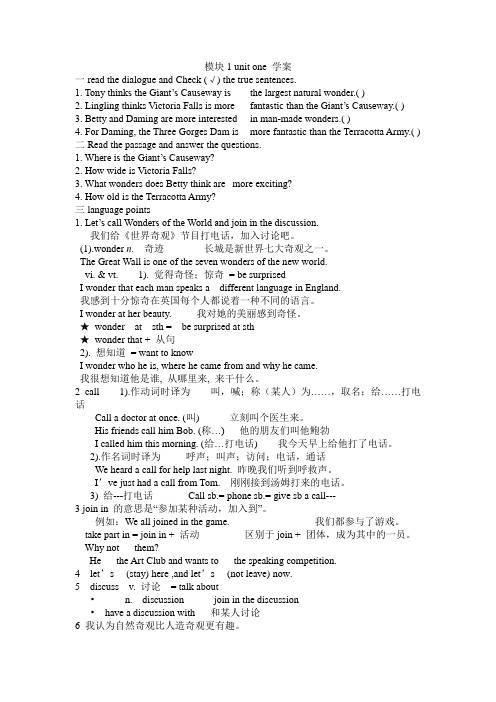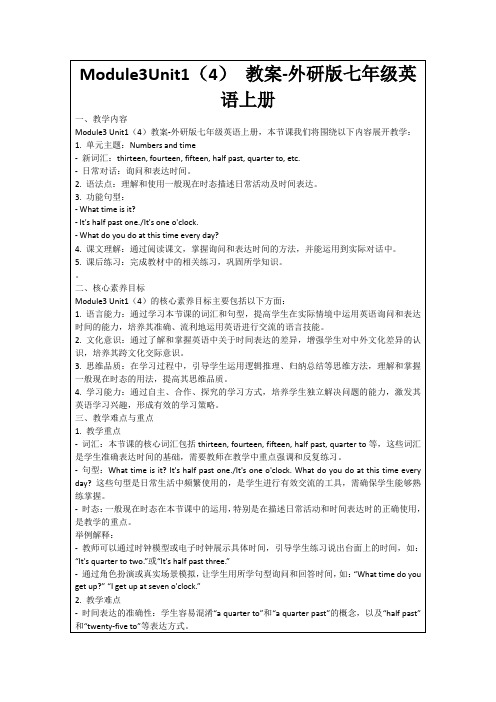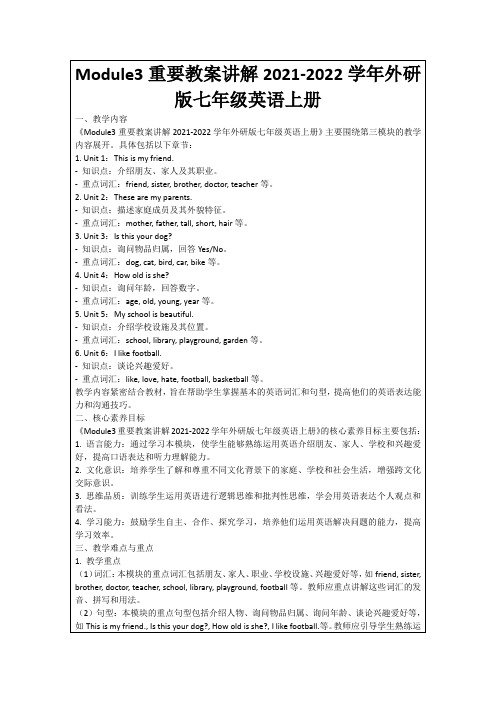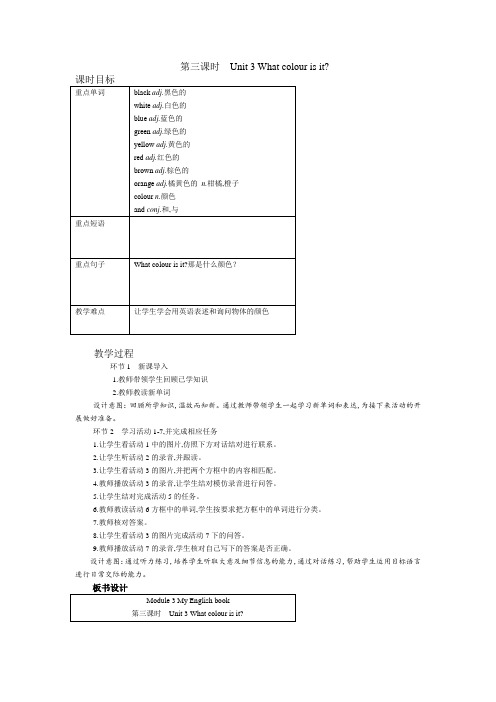外研版七年级英语上册教案Module3
外研版七年级英语上册 Module3 unit1教案 (3)

模块1 unit one 学案一read the dialogue and Check (√) the true sentences.1. Tony thinks the Giant’s Causeway is the largest natural wonder.( )2. Lingling thinks Victoria Falls is more fantastic than the Giant’s Causeway.( )3. Betty and Daming are more interested in man-made wonders.( )4. For Daming, the Three Gorges Dam is more fantastic than the Terracotta Army.( ) 二Read the passage and answer the questions.1. Where is the Giant’s Causeway?2. How wide is Victoria Falls?3. What wonders does Betty think are more exciting?4. How old is the Terracotta Army?三language points1. Let’s call Wonders of the World and join in the discussion.我们给《世界奇观》节目打电话,加入讨论吧。
(1).wonder n. 奇迹长城是新世界七大奇观之一。
The Great Wall is one of the seven wonders of the new world.vi. & vt. 1). 觉得奇怪;惊奇= be surprisedI wonder that each man speaks a different language in England.我感到十分惊奇在英国每个人都说着一种不同的语言。
外研版英语七年级上册Module 3教案

外研版英语七年级上册Module 3教案Book1 Module 3 My school一、教学内容:Unit1 There are thirty students in my class.二、课型:Listening and speaking三、教学目标:1、能正确运用本单元的词汇及短语:computer, furniture, map, picture, television, wall, thirty, forty,fifty, sixty, seventy, eighty, ninety, really, many, howmany, there, a lot of, any, world 。
2、能听懂介绍学校的简单对话。
3、能掌握“there be”句型的肯定、否定、一般疑问及特殊疑问句式和相应回答.并能运用此句型来介绍自己教室的样子。
4、能向同学们描述自己理想的教室的样子,如对自己理想教室的样子的设想等。
四、教学重难点:掌握“there be”句型的肯定、否定、一般疑问及特殊疑问句式和相应回答.并能运用此句式来介绍自己教室的样子。
五、教学准备:本课指导学生通过听力获取信息,培养学生听力技能。
课堂上采用多媒体手段辅助教学,在轻松愉快的氛围中,在较真实的语境下,并联系学生生活实际,结合已有的知识和经验,运用所学的语言基础知识自我学习、互相学习,让学生在语言实践中相互启发、生成,体验成功。
培养学生的合作精神,发展其思维和想象等能力。
在教学过程中,采用多媒体手段辅助教学,利用各种图片和习题任务贯穿整个教学过程。
因此,本节课需准备:PPT课件、挂图、录音机、课堂练习表格、奖品。
六、预习要求:根据音标自学本课新单词;七、教学过程:教学步骤教师活动学生活动设计意图Step On e Warming -up (3’)Lead in1.Free talk:(1)Show some pictures and ask Ss like these:What’s in the picture?Is/Are there …?What’s in the classroom?There is/are …(2)Show more pictures and let Ss talk about them and learn some new words, try touse the sentences with “There is/are….”1. Answer thequestions.2. Talk with partners, learn some new wordsand try to use the sentences with “There is/are...”让学生在free talk的过程中感受新的语言项目,通过这个环节,既可以活跃课堂气氛,还调动了学生的学习兴趣。
Module3Unit1(4)教案-外研版七年级英语上册

五、教学反思
在今天的教学过程中,我发现学生们对时间表达这一主题非常感兴趣,他们在角色扮演和小组讨论中都表现得很积极。通过这些活动,学生们在实际语境中练习了英语时间表达,这有助于他们更好地理解和记忆相关词汇和句型。
举例解释:
-教师可以使用图表或时间线来帮助学生理解“a quarter to”和“a quarter past”的区别,通过实际时钟操作来强化记忆。
-创设情境,让学生在具体语境中练习时态,如制作一个关于“daily routine”的时间表,要求学生用一般现在时描述每个时间段的习惯性活动。
-通过听力和发音练习,帮助学生准确掌握词汇的发音,可以采用分组竞赛、个人展示等形式,提高学生的学习兴趣和参与度。
2.教学难点
-时间表达的准确性:学生容易混淆“a quarter to”和“a quarter past”的概念,以及“half past”和“twenty-five to”等表达方式。
-时态的正确运用:在描述习惯性动作和一般性事实时,学生可能会错误地使用其他时态,如过去时或将来时。
-词汇的发音:某些数字和时间词汇的发音对学生来说可能是一个挑战,如“thirteen”和“fourteen”中的“-teen”音节。
3.重点难点解析:在讲授过程中,我会特别强调如何用一般现在时态表达习惯性动作,以及“a quarter to”和“a quarter past”等时间短语的正确使用。对于难点部分,我会通过举例和比较来帮助大家理解。
(三)实践活动(用时10分钟)
初中英语外研版七年级上册Contents《Module 3 My school》优质课公开课教案教师资格证面试试讲教案

初中英语外研版七年级上册Contents《Module 3 My school》优质课公开课教案教师资格证面试试讲教案1教学目标To understand the conversations involving introduction of class & classroom2学情分析Module 3 My school,是外研版教材七年上册的内容。
主要学习There be 句型的用法、二十以上的大数字.能用所学句型和单词描绘教室。
3重点难点There be 句型的用法、二十以上的大数字.There be 句型的单复数、否定及疑问句形式的用法.4教学过程4.1第一学时教学目标To understand the conversations involving introduction of class & classroom 学时重点There be 句型的用法、二十以上的大数字.学时难点There be 句型的单复数、否定及疑问句形式的用法.教学活动1【导入】Unit 1 There are thirty students in my class.Class,Look around our classroom .What can you see?Some students answer the questions:blackboard,desk,chair .......Yes,Can you speak them in English?No,Today we learn how to speak them in English2【讲授】Unit 1 There are thirty students in my class.■Vocabulary and listening1.Look at this picture,what is it?It’s a wall.What are these?furniture.。
Module3重要教案讲解2021-2022学年外研版七年级英语上册

2.文化意识:培养学生了解和尊重不同文化背景下的家庭、学校和社会生活,增强跨文化交际意识。
3.思维品质:训练学生运用英语进行逻辑思维和批判性思维,学会用英语表达个人观点和看法。
4.学习能力:鼓励学生自主、合作、探究学习,培养他们运用英语解决问题的能力,提高学习效率。
(4)文化背景:本模块涉及到不同文化背景下的家庭、学校和社会生活,学生可能对此感到陌生。教师可通过图片、视频、实物等手段,帮助学生了解和尊重不同文化。
(5)口语表达:学生在用英语介绍自己、家人和学校时,可能存在表达不流畅、词汇量不足等问题。教师应鼓励学生多开口练习,提供丰富的语言素材,提高学生的口语表达能力。
三、教学难点与重点
1.教学重点
(1)词汇:本模块的重点词汇包括朋友、家人、职业、学校设施、兴趣爱好等,如friend, sister, brother, doctor, teacher, school, library, playground, football等。教师应重点讲解这些词汇的发音、拼写和用法。
4. Unit 4:How old is she?
-知识点:询问年龄,回答数字。
-重点词汇:age, old, young, year等。
5. Unit 5:My school is beautiful.
-知识点:介绍学校设施及其位置。
-重点词汇:school, library, playground, garden等。
在今后的教学中,我将进一步优化教学策略,关注学生的个体差异,提高教学质量。同时,我也会鼓励学生们多开口说英语,增加课堂互动,激发他们的学习兴趣,提高英语实际运用能力。
外研版七年级英语上册《Module3MyschoolUnit3》说课稿

外研版七年级英语上册《Module 3 My school Unit 3》说课稿一. 教材分析外研版七年级英语上册《Module 3 My school Unit 3》的主要内容是介绍学校的一些场所和设施,如教室、图书馆、实验室、食堂等。
通过本节课的学习,学生能够掌握有关学校场所和设施的词汇,能够用英语简单介绍自己学校的设施和特点。
二. 学情分析七年级的学生已经掌握了基本的英语语法和词汇,具备一定的听说读写能力。
但部分学生对学校的场所和设施可能还不太熟悉,因此需要在课堂上引导学生进行观察和思考,帮助他们更好地理解和掌握相关词汇。
三. 说教学目标1.知识目标:学生能够掌握有关学校场所和设施的词汇,如classroom,library, laboratory, canteen等;能够用英语简单介绍自己学校的设施和特点。
2.能力目标:学生能够通过观察和思考,运用所学词汇进行口头和书面表达。
3.情感目标:培养学生对学校的热爱和自豪感,增强他们的集体荣誉感。
四. 说教学重难点1.重点:学生能够掌握有关学校场所和设施的词汇,能够用英语简单介绍自己学校的设施和特点。
2.难点:学生能够运用所学词汇进行口头和书面表达,特别是对学校的不熟悉的部分。
五. 说教学方法与手段1.交际法:通过小组讨论、角色扮演等形式,让学生在实际语境中运用所学词汇,提高他们的口语表达能力。
2.任务型教学法:通过完成各种任务,如观察学校场所和设施,让学生在实践中学习和运用词汇。
3.多媒体教学:利用图片、视频等教学资源,帮助学生更直观地理解和记忆词汇。
六. 说教学过程1.导入:教师通过提问方式引导学生谈论自己学校的设施和特点,激发学生的学习兴趣。
2.新课呈现:教师展示学校场所和设施的图片,引导学生说出相应的词汇,并板书重点词汇。
3.操练环节:学生分组进行角色扮演,模拟在各种学校场所和设施中的情景,如在图书馆借书、在实验室做实验等。
4.任务型活动:学生分组观察学校的场所和设施,用英语记录下自己的观察结果,并互相交流。
外研版七年级英语上册 Module3 My school Unit1教案

Book Module3Unit1There are thirty students in my class.______________________________一、认识新单词▲短文Daming: Linda, what's your classroom in England like? Is it big?Linda: Yes, it's really big. There are thirty students in my class.how many students are there in your class in Beijing?Daming: There are forty students, twenty girls and twenty boys. what's in your classroom? Is there a lot of furniture?Linda: Yes, there is.Daming: Are there computers on everyone's desk?Linda: No, there aren't. But there is a computer on the teacher's desk. Daming: Oh,are there any pictures on the classroom walls?Linda: Yes, there are, at the front of the classroom.Daming: And is there a map of the world?Linda: No,there isn't. There's a map of England.Daming: There's a map of the the world in our classroom,but there aren't any pictures on our walls.【知识点讲解】一、What’s your classroom in England like?1. What’s …like?这个句型用来询问“……是什么样?”这个的like 是介词,意为”像”句型结构:what+be+sb/sth like?用于提问物的样子;或人的性格,外貌.例1 What’s your house like? 你的房子是什么样的?It’s very big.例2 What’s your Chinese teacher like?你们的语文老师怎么样?She is very kind.她很和蔼。
外研版七年级英语上册教案Starter Module 3 Unit 3

第三课时Unit 3 What colour is it?
教学过程
环节1 新课导入
1.教师带领学生回顾已学知识
2.教师教读新单词
设计意图:回顾所学知识,温故而知新。
通过教师带领学生一起学习新单词和表达,为接下来活动的开展做好准备。
环节2 学习活动1-7,并完成相应任务
1.让学生看活动1中的图片,仿照下方对话结对进行联系。
2.让学生听活动2的录音,并跟读。
3.让学生看活动3的图片,并把两个方框中的内容相匹配。
4.教师播放活动3的录音,让学生结对模仿录音进行问答。
5.让学生结对完成活动5的任务。
6.教师教读活动6方框中的单词,学生按要求把方框中的单词进行分类。
7.教师核对答案。
8.让学生看活动3的图片完成活动7下的问答。
9.教师播放活动7的录音,学生核对自己写下的答案是否正确。
设计意图:通过听力练习,培养学生听取大意及细节信息的能力,通过对话练习,帮助学生运用目标语言进行日常交际的能力。
练习设计
请完成本课对应训练!。
- 1、下载文档前请自行甄别文档内容的完整性,平台不提供额外的编辑、内容补充、找答案等附加服务。
- 2、"仅部分预览"的文档,不可在线预览部分如存在完整性等问题,可反馈申请退款(可完整预览的文档不适用该条件!)。
- 3、如文档侵犯您的权益,请联系客服反馈,我们会尽快为您处理(人工客服工作时间:9:00-18:30)。
Module 3 My new school一.教材内容分析本模块以学校为话题,把焦点放在对学校的介绍上,话题贴近学生生活;新生对介绍学校也比较感兴趣。
教学中应结合学生实际情况,灵活调整教学内容(或增加,或删除,或前后调整),合理设置课时。
适当进行拓展,以丰富学生知识,拓展学生视野,进行理想、人生规划的教育。
二.学情分析通过前面两个模块的学习,学生掌握了部分描述物品的词汇及介绍自己的句型。
本单元则是在前两个模块的基础上引入到学校与班级这个话题上,这是学生很熟悉也是较感兴趣的话题。
在教师预设的任务中,引导学生在交际中动态生成,学生有话可说,乐于合作分享。
这样就有利于他们更好的运用课本知识,达到提高综合运用语言能力的目的。
三.教学目标1.语言知识目标2.语言技能目标3.学习策略目标4.文化意识目标:在中外对比中,了解不同国家的学校发展情况,了解不同国家的学校教育。
5.情感态度目标培养学生热爱学校,热爱自己家园的意识。
参加各种英语活动,克服困难,在新环境中进一步树立正确的语言学习观。
四.重点难点1. 教学重点}[1] 重点句型:there be 句型表示存在的肯定,疑问与否定形式[2] 重点话题:Introduce a school, a class, identify different places2. 教学难点[1] 数词与名词连用时,名词的单复数的使用。
[2] 掌握there be句型。
[3] 描述自己的班级和学校,能用恰当地道的英语进行写作练习。
五、教学设计~Unit 1 There are thirty students in my class.Teaching Aims and Demands:1. 知识目标:掌握下列重点单词和词组的意思及用法there, forty-six, computer, map, dictionary, wall, library, picture, television, right, fifteen, sixty, seventeen,eighteen, thirty, forty, fifty, sixty, seventy, eighty, ninety, many, how many, any, tree2. 能力目标:能在实际情境中运用句型:there is / there areCan introduce one’s classroom.3.情感目标:培养学生热爱学校,热爱自己家园的意识。
Teaching main points and difficult points:1.重点:There is a/ an….There are2.难点:There is a/ an….There are …的具体用法.Teaching Aids: Multi-Media (or Tape recorder, OHP)Teaching Procedures:Step 1 Leading-in1. Ss look the pictures and answer the questions.T:What school are you inS:I am in No. 1 Middle School.T:What class are you in"S:I’m in Class Two.T:How many students are there in your classS:There are 30 students in my class.Step 2 Consolidate new words1. Look and teachers shows the pictures of new words and let the students to say as quickly as possible.2. Find and teacher shows pictures of different numbers, and the students find the right numbers.Step 3 Look and sayLook at the pictures and talk about them according to the following words.\blackboard, book, classroom, computerdesk, funiture, map, picture, television, wallStep 4 ListeningListen and choose the right pictures.20 twenty 30 thirty 40 forty 50 fifty 60 sixty70 seventy 80 eighty 90 ninetyStep 5 Listen and readand tell true or false.[There are thirty students in Linda’s class.( )There is a map of the world in Linda’s class.( )the dialogue and fill in the form.out the main points in the dialogue.Step 6 Grammar1. (1).Find the declarative sentences from 3.(2).Point out the use of the declarative sentences and the negative sentences in “there be”.(3).Do some exercises.2. (1).Find the general interrogative sentences from3.(2).Point out the rules about how to change into interrogative sentences.@Step 7 Look and say1.Look at Picture 1 and the teacher show how to answer the generalinterrogative sentence.Is there a blackboard in the classroomYes, there is .2.Ss answer the questions in the following pictures.3.Look at the picture and the teacher show how to answer the special question.4.Ss answer the questions in the following pictures.Step 8 Make a survey~Work in pairs. Write about your classroom. Use numbers.How many…Numbersdeskstelevisionsstudents`blackboardspicturescomputersStep 9 Talk about your ideal classroom(A:How many …are there in your classroomB:There are …A:Is there a …B:Yes, there is./No, there isn’t.A:Are there …B:Yes, there are./No, there aren’t.Step 10 Listen and repeat/ʌ/ some—/a:/ are classroom/ə/ computer teacher/ə:/ girl thirtyStep 11 SummaryThere be结构中的be的单复数取决于后面紧跟的名词。
There be结构的疑问句是把be提前。
Some在否定句和疑问句中要变为any。
Step 12 Exercises%Step 13 Homework课后准备一个对话,介绍你理想的….Unit 2 The library is on the left of the playground. Teaching Aims and Demands:1. 知识目标:掌握下列重点单词和词组的意思及用法dining hall, gym, sciencelab, in front of, next to, behind2. 能力目标:能在实际情境中运用句型:Where is… It’s / Where are…. They’re…. ~Can use the prepositions of the places.3.情感目标:To talk about our school and design our school.Teaching main points and difficult points:1.重点:To get information from the reading material about the library;To talk about the locations.2.难点:To improve the Ss’ reading ability.Teaching Aids: Multi-Media (or Tape recorder, OHP)Teaching Procedures:Step 1 Leading-inSs look at the pictures and answer the questions.T: What is this building&S:It’s a library.T: Where is the libraryS:It’s in my school.Step 2 Consolidate new wordsLook and say. The teachers shows the pictures of new words and let the students to say as quickly as possible.Step 3 Look and chooseLabel the pictures with the words and expressions from the box.?Step 4 Look and sayLook at the pictures and say the right prepositions and prepositional phrases.Step 5 Read and writeRead Betty’s words and write her classmates’ names on their desks.In the classroom, Daming’s on my right.Gao Yan’s in front of Daming and between Zhao Feng and Li Min. Lingling is behind Zhao Feng.Step 6 Listen and answerListen the passage and answer the questions.^many buildings are there in the school’s in the libraryStep 7 Read and labelRead the passage and label the map of the school using the following words and phrases of the places.Step 8 Read and answerthe passage again and answer the questions.(1)How many classrooms are there in the classroom building)(2)Where are the computer rooms and science labs(3)What’s on the right of the libraryout the language points.Step 9 Grammarbe结构的一般疑问句是把be提前。
